Blog
Tech Insigths
Five steps to build a successful IoT application
Learn the steps to build a complete IoT solution. We've added a few tips to help you get to market faster and increase your chances of sucess.

TagoIO Team
Dec 8, 2022



There are many opportunities in the IoT market today, especially as IoT technology continues to evolve and become more accessible with smaller sensors, more potent batteries, and new ways to transmit data.
However, the IoT application development process may not be something simple, as there are many things to take into consideration to create a successful IoT solution. These things include identifying a profitable use case, choosing the right sensors, finding the best way to send your data with the correct network and protocol, and managing data storage and processing. But fear not; we are here today to help you by sharing five steps to consider when creating your first IoT application.
1. Finding your use case
The first step for an IoT project is finding your use case and being clear about the benefits you want to obtain from the project. A use case helps to identify a situation’s specific needs and requirements, allowing for more tailored and effective solutions. For example, in the healthcare industry, there could be a need for better communication between doctors and patients. However, defining the specific use case — such as improving communication during hospital visits or facilitating follow-up appointments via phone or online — can lead to different approaches, each with its own unique benefits and challenges.
After you find the problem you want your use case to deal with, it’s crucial to establish if there are already existing solutions on the market. If not, ask yourself why? Your use case doesn’t have to be innovative, but it needs to be rentable, which means it must be able to generate revenue and fulfill a specific need to be a successful IoT product.
Some examples of use cases in the IoT market include:
Connected home applications that allow users to control appliances, monitor energy usage, and receive security warnings.
Smart city initiatives that use sensors to collect data on traffic flow, noise levels, and more.
Industrial IoT systems that help manufacturers optimize production processes and improve asset utilization.
Retail solutions that track customer behavior and measure the effectiveness of marketing campaigns.
Improving supply chain management by tracking shipments, inventory levels, and temperature in real-time.
As you can imagine, the possibilities for applications are many — it all comes down to identifying an opportunity and finding a way to make it work.
2. Choosing your IoT devices
Once you have identified your use case, the next step is to choose the right IoT devices for your application. Some important factors to consider when choosing devices include:
The frequency your IoT system needs to collect data, for example, real-time or batch.
Whether data storage and processing capabilities are needed on the device or in the cloud.
The types of connectivity networks available and whether they meet your needs.
Battery life and other requirements, such as size, weight, or ruggedness.
The type of data that needs to be collected, such as temperature, location, or vibration.

Types of IoT sensors
Many different types of sensors are available on the market today, each with its own focus. Some popular choices include:
Temperature, humidity, and pressure sensors for monitoring weather conditions in smart cities or industrial applications.
Displacement sensors to track the position and movement of machines, vehicles, or other objects.
Gas sensors for detecting air quality and environmental hazards in industrial facilities.
Accelerometers, gyroscopes, and magnetometers for measuring motion, orientation, and direction in mobile devices or IoT applications.
GPS and other location sensors for tracking the precise position of assets or people
Before committing to using any particular IoT device, it is vital to do thorough research and test them out in a real-world environment whenever possible. Besides choosing an existing sensor, another viable option is to develop your hardware.
IoT device providers
Your IoT sensors will most likely need to be purchased from a reliable provider, so it is important to do your research and find one that meets your application needs. Some popular providers of IoT devices include Tektelic, Khomp, RAKwireless, Dragino, TE Connectivity, and Milesight.
A viable option while looking for IoT devices is to search for development kits, which typically include a range of pre-configured sensors and make it easier to deploy your IoT solution quickly. In addition, since development kits are usually made to be easily expanded and easy to use, they are great options to scale up.

Other hardware components that your IoT solution may need include wireless modems, microcontrollers, batteries, interface cables, and more. You must also consider compatibility with other devices, systems, future upgrades, and expansions.
3. Selecting a network and protocol for data transmission
Together with IoT devices, it is important to carefully consider the network and communication protocols that will be used. Depending on the specific requirements of your IoT system, options might include wireless local area networks like Wi-Fi, Bluetooth, LoRa, LoRaWAN, Zigbee, Cellular, Satellite, or Sigfox.

Things to take into consideration while selecting a network and protocol for your IoT application include the following:
Bandwidth: Will the network be able to handle the volume of data generated by your devices?
Latency and reliability: How quickly will you need the data from your devices to reach the cloud, and how reliable does that transmission need to be?
Security: You will also need to ensure the network is secure and does not pose any privacy or data integrity risks.
Availability: Will there be adequate coverage where your devices will be deployed? A network for a hospital application may not be available for tracking or smart farms.
Energy consumption: Will this device be battery-operated? If so, how often does it need to be replaced?
Depending on what IoT hardware you choose for your application, your sensors will communicate with a gateway, which in turn communicates with the cloud. In a situation where there is a gateway, the network and protocol might be different. For example, a sensor might send data using LoRaWAN to the gateway, and then the gateway might communicate with the system by HTTPS.

4. Storage/processing data
The cloud and the edge are the two most common options for storing and processing data for IoT applications.
The cloud: Using a cloud-based IoT platform to store and process data from your sensors, devices, and systems can make it easier to integrate with other systems or applications and scale as your needs grow. However, cloud technology often comes at a cost in terms of bandwidth usage and overall costs for the platform itself.
The edge: Some IoT applications may benefit from storing data on the device and performing specific tasks, such as filtering or anomaly detection locally. Edge computing brings advantages in terms of latency and security, but can be more challenging to implement and maintain at scale.
5. The IoT platform
Usually, IoT applications will end up on a platform that puts together all the steps above. An IoT platform lets your user interact with the data and take action. Using an existing platform may speed up the process since things like connection, storage, integrations, and many things we discussed are ready to use.
As you can expect, there is no single IoT platform that will meet every IoT application’s needs; rather, you will need to carefully consider the different factors and choose between the IoT platforms the one that best matches your requirements, or you might even consider creating your own.
Some things to look for in an IoT platform include the following:
Cost: How much does the platform cost to use, and how does that compare with other options?
Supported devices and networks: Will you be able to easily integrate the platform with your own devices or those created by third parties?
Scalable: Will the platform be able to scale as your needs grow?
Dashboard customization: Does the platform offer customizable dashboards and reports that meet your needs?
Integrations: How easily can you integrate with other systems, such as databases, CRM tools, weather APIs, tracking APIs, or any external web services?
Some platforms have ready-to-go applications that facilitate building an IoT application. These platforms also have extensive tools and resources, such as IoT dashboard templates and tutorials, that can help you get started quickly.
An excellent example of a platform to manage IoT applications is TagoIO. TagoIO has ready-to-go applications and a set of tools that can help you smoothly develop your application. You can also easily connect devices to it, such as sensors, actuators, or even other APIs. Additionally, it comes with extensive documentation and support options in case you run into any issues.
In conclusion
Building a successful IoT application can be a life-changing experience, but be aware that a lot of work is involved. You will need to consider factors such as the application’s use case and requirements, your data processing needs, the IoT platform you’ll build upon, the devices you will be working with, and the available connectivity options.
If you’re planning to build an IoT project from scratch, it may be a good idea to start by doing some research and experimenting with existing platforms and tools. This will help you decide what kind of application you want to create, what technologies are best suited for your needs, and how complex the implementation process is likely to be.

TagoIO Team


